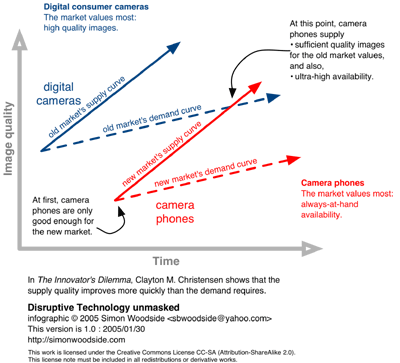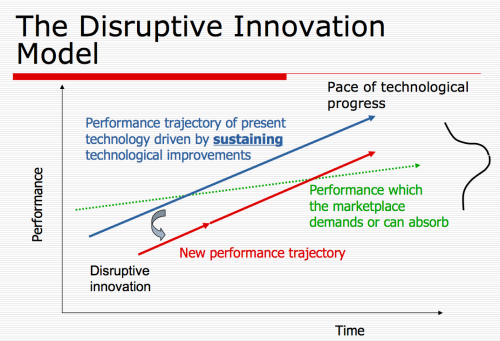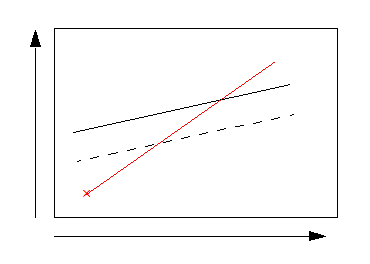Disruptive Technology Biography
A disruptive innovation is an innovation that helps create a new market and value network, and eventually goes on to disrupt an existing market and value network (over a few years or decades), displacing an earlier technology. The term is used in business and technology literature to describe innovations that improve a product or service in ways that the market does not expect, typically first by designing for a different set of consumers in the new market and later by lowering prices in the existing market.
In contrast to disruptive innovation, a sustaining innovation does not create new markets or value networks but rather only evolves existing ones with better value, allowing the firms within to compete against each other's sustaining improvements. Sustaining innovations may be either "discontinuous"[1] (i.e. "transformational" or "revolutionary") or "continuous" (i.e. "evolutionary").
The term "disruptive technology" has been widely used as a synonym of "disruptive innovation", but the latter is now preferred, because market disruption has been found to be a function usually not of technology itself but rather of its changing application. Sustaining innovations are typically innovations in technology, whereas disruptive innovations change entire markets. For example, the automobile was a revolutionary technological innovation, but it was not a disruptive innovation, because early automobiles were expensive luxury items that did not disrupt the market for horse-drawn vehicles. The market for transportation essentially remained intact until the debut of the lower priced Ford Model T in 1908.[2] The mass-produced automobile was a disruptive innovation, because it changed the transportation market. The automobile, by itself, was not.
The current theoretical understanding of disruptive innovation is different from what might be expected by default, an idea that Clayton M. Christensen called the "technology mudslide hypothesis". This is the simplistic idea that an established firm fails because it doesn't "keep up technologically" with other firms. In this hypothesis, firms are like climbers scrambling upward on crumbling footing, where it takes constant upward-climbing effort just to stay still, and any break from the effort (such as complacency born of profitability) causes a rapid downhill slide. Christensen and colleagues have shown that this simplistic hypothesis is wrong; it doesn't model reality. What they have shown is that good firms are usually aware of the innovations, but their business environment does not allow them to pursue them when they first arise, because they are not profitable enough at first and because their development can take scarce resources away from that of sustaining innovations (which are needed to compete against current competition). In Christensen's terms, a firm's existing value networks place insufficient value on the disruptive innovation to allow its pursuit by that firm. Meanwhile, start-up firms inhabit different value networks, at least until the day that their disruptive innovation is able to invade the older value network. At that time, the established firm in that network can at best only fend off the market share attack with a me-too entry, for which survival (not thriving) is the only reward.[3]
The work of Christensen and others during the 2000s has addressed the question of what firms can do to avoid oblivion brought on by technological disruption.
Disruptive Technology
Disruptive Technology
Disruptive Technology
Disruptive Technology
Disruptive Technology
Disruptive Technology
Disruptive Technology
Disruptive Technology
Disruptive Technology
Disruptive Technology
Disruptive Technology
Disruptive Technology
Disruptive Technology
Disruptive Technology
Disruptive Technology
Disruptive Technology
Disruptive Technology
Disruptive Technology
Disruptive Technology
Disruptive Technology
Disruptive Technology




















No comments:
Post a Comment